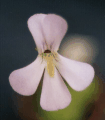 plants with summer leaves, July 1996
plants with summer leaves, July 1996
 extreme closeup of flower in cultivation, August 1996
extreme closeup of flower in cultivation, August 1996
Pinguicula jaumavensis is closely related to Pinguicula esseriana and Pinguicula ehlersiae, but the flowers differ in many points from the 2 other species. As many Mexican Pinguiculae, the plants occur on vertical cliffsides, often gypsum or limestone hills. In winter the plants are forming succulent, non-carnivorous winter leaves. Cultivation is quite easy. I use a soil which consists of 50% sand, 30% calcerous soil and 20% peat. In winter I keep the plants almost dry, while in summer P. jaumavensis needs wet soil. Flowering period is in summer.
P. jaumavensis belongs to the tropical heterophyllous growth-type. This species is close to P. ehlersiae and P. esseriana. Summer rosettes are about up to 4 cm in diameter. When the plants are exposed to sunlight or a bright source of flourescent light, leaves getting burgundy in colour, sometimes only nervs of the leaf are reddish. The winter rosette consists of up to 30 thinner non carnivorous leaves. I made the observation that if plants are kept quite dry and cool in winter, it's more likely that the plants form their winter rosettes. In cultivation flowers occured in summer and in winter (while P. esseriana only flowered in winter). I cultivate this species in a mixture of calcerous clay and sand. Multiplication is easy by leaf cuttings.
Oliver Gluch
Lindenallee 44
26122 Oldenburg
Germany
Phone/Fax: ++49 441 72618
eMail: Oliver.Gluch@t-online.de